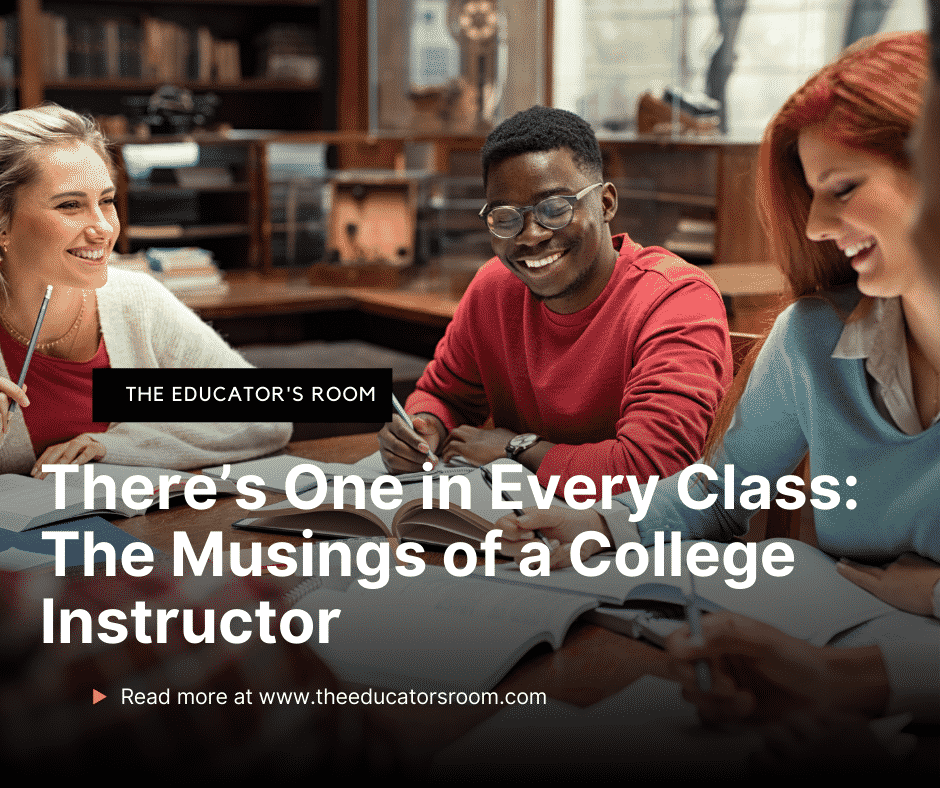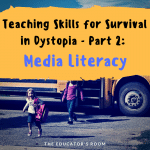Steve is currently the Director of the Rose Warner Writing/Critical Thinking Center at the College of Saint Scholastica. He has been teaching college composition for over 30 years, working with students from a diverse range of institutions, including high school, community college, university, a state prison and even overseas (The American University in Cairo). His most recent article, “The Dea(r)th of Critical Thinking”, appeared in the Mpls. Star Tribune June 12, 2021.

Dale slouched in the back of the room, his right foot balanced on the armrest in front of him. He crossed his arms. Only a Styrofoam coffee cup from the student center graced his desk. So much gel ran through his hair it looked like he’d just exited a wind tunnel. A struggling blonde goatee was blooming over his chin. With his back to the wall like Wild Bill Hickok at Nuttal and Mann’s, he fidgeted for a second, loosening up his arms, working his mouth into a distorted pucker. I half expected him to draw on me. Instead, he reached for his cup, drew it to his mouth, looked inside, and then, chewing vigorously, unloaded a mouthful of tobacco.
I knew we were a tobacco-free college—meaning you couldn’t smoke on campus—but I was not so sure about policies on chewing tobacco. On the edges of my mind, I determined either way it would be problematic.
However, this was the first day of class, and I had to get through lots of material. Stray thoughts about tobacco usage were disrupting my focus. For half the winter break, three weeks I usually savored, I wrestled with my first-year writing syllabus. I had been unhappy with the results from the previous semester and decided I needed to change some basic elements of my class structure to connect more fully with millennials, like finding shorter readings, truncating the length of essay assignments, telescoping lectures from 15 minutes to five. I was not going to go through that again. The fall semester class had been one of the worst in years.
The reason?
A “know-it-all” “eye-roller” who took wild joy in every confrontation she could set up and set off. The first confrontation seemed relatively harmless. During the second week, she raised her arm and said, “Why aren’t we writing more papers?”
She shot me a dark-eyed glare.
I told her we had already written, in the first two weeks, five pages of prose. I said, “You should have two pages of journal writing by now. What have you been journaling about?
She pouted. “Passive-aggressive entries about why we’re not writing.”
Really? Not only was she upset with class; she was aware of being passive-aggressive about it.
By midterm, I was terrified to even enter the classroom and hoped—prayed—she’d drop; to my surprise, she actually would come to the room 20 minutes early. This was a new breed of student, one who wouldn’t speak to me in general (she chirped a clipped “yes” or “no” if she had to) but who wanted in the worst way to engage in wrestling matches through body talk: she glared, she rolled her eyes, she gnawed on her pencil, she sighed, she elbowed her confidante and smirked. On and on it continued even after I politely wondered aloud if something was troubling her. “Nope,” she peeped.
Once, wandering class during a discussion of Orwell’s “Shooting an Elephant,” I happened to pass behind her and asked her what she was doing on her computer. A host of different shoe styles was on display in front of her. She told me she was purchasing shoes. And she gave me the duh look.
What relief I felt at the end of the fall semester when I wrote “2:00” on the board, signaling students to stop writing and joyfully watching her exit my life for good. As the days passed, I grew excited again for the new semester, as I always had for those first few days, and suddenly I’m staring at Deadeye Dick, who’s just slipped another massive gob of chew into his mouth even before I’ve passed out the syllabus.
When I confronted him about chewing tobacco not being allowed, he said, “I’m in training for baseball.”
“You’ll need to either leave or get rid of the chew.”
He kicked himself up, grabbed his cup, stood with his bookbag, and left the classroom.
Much relieved, I considered the issue. Looking back over the many years of teaching, I determined there’s one in every class, a student who drives me crazy, who is just enough of an instigator (or even hellion) to make the class less than pleasant—a rebel, an entitled, self-absorbed chatterbox, a slowly steaming volcano, an aloof know-it-all, or a childish brat. On down the line, I could summon up that one student who, from day one, seemed to stick out like a sore thumb, the one who I could predict would either take the class over and make it a painful semester or eventually pack up her bags and disappear just before I blew up.
They’re easy to spot.
Once, while class was freewriting about my “what I hate most about writing” prompt, one student passed out Mike and Ike candies, and when he finished with his box, he crumpled it up and basket-balled it into the trash. After he missed the garbage can, he stood up and began punting the crushed green box. I politely asked him what he thought he was doing, requesting that he play football after class and kindly take his seat. His response: “You don’t want me to litter, do you?”
I knew I was in for it.
For a while, I would scour the first and second days of class, just waiting for that one individual to show herself, sometimes hoping that this time, that one student had not signed up for English 1110, Tuesdays and Thursdays at 8:00 a.m. After all, it was early, and most trouble makers, I assumed, were sleeping in. Still, if I were honest, I knew I could go through my grade books and determine each class who had been the monster. Once, it was obvious: When asked what his favorite activity was, Darryl told the class that he’d converted his dorm room into a “gaming” center. Thankfully, he was gone after three or four classes and we no longer had to put up with his snoring.
My favorite was Monica. She hid behind a Big Gulp the first day and when I was through explaining the syllabus, she shot up her hand and asked, “What the hell is an essay?” She also asked me if the papers had to be typed as they did not allow typewriters in prison. When I asked her to help me out with that, she told the class she had tied her husband to a chair and held him, hostage, with a gun for five hours while detailing every abuse he’d committed upon her person. I knew I was in for a long semester but made sure I gave Monica an A.
To combat this phenomenon, I’ve come up with three strategies that seem to work for me.
Strategy number one: Get it out of the way. Usually, ice breakers are good places to identify the culprit. When one of our “Chatpack” questions, “what job would you absolutely refuse to perform even if you were paid a million dollars?” was answered by Kellen Lamb “gynecologist”, I knew he was the one, and I told him so. After class, we had a nice conversation about how to get around that need of his for attention and subversion and the need of the class for respect and harmony. By the end of the semester, Kellen had become an exceptional student and funneled his “high-school” class clown behavior into productive class engagement after I told him I expect and admire challenges to authority as long as they are respectful and thoughtful.
In a different ice breaker, I had students draw pictures of themselves from a generic circle on a piece of paper I passed out to them, a picture that “reflects their inner selves”. One artist drew himself as the caricature of the Minotaur’s face, only he didn’t know it. I pegged him right off and remained vigilant to his behaviors. Sure enough, after only two classes, he did not smile once and did not make any facial expressions other than the bull’s scowlish hostility. I wondered aloud how he was feeling about the recent “peer review,” and after I learned that practice drove him “crazy”, I sat down nearby and listened while he unloaded to me and the class several minutes of vitriol about all the ways higher education “straightjackets” students. I asked what he’d like to do differently short of leaving the room, and he laid out a plan we could all agree on. A few days later, his facial expressions softened. I handed him another empty circle on a piece of paper and asked if he’d like to revise his picture. He happily accepted.
Strategy number two: Make the student the teacher so they can learn that we see everything: Jon picking his nose, Jan texting, Jake talking to Julian, Jarrod sleeping, and Jade rolling her eyes. How can’t students know this? Once they learn what it is like to see them and experience their behaviors, they tend to think twice before they take that daring step into disrupting the teacher’s heart and mind. The best way to teach empathy is to literally place the student in the teacher’s shoes. My favorite time is when I get to heckle them during their presentations. I sit in the back and text, talk, sleep (give the full bore snore job), fall out of my desk, and make inappropriate jokes. What fun!
Strategy number three: Humor never hurts. When visited by smartalec writers who make fun of your assignments to undermine the seriousness of the academic traditions, turning your brilliant essay questions on their heads, or when confronted by those ever so smarmy and clever outsiders who have secretly been studying your subject longer than you’ve been alive and who now want to deliver on their genius deliberation—i.e. a quirky diatribe for example about Melville’s penchant for plagiarism along with the rest of the western canon, demanding these “scribblers” suffer the same fate as the students (sending their works to Turnitin.com)—beat them to the punch. Crack a joke. Or give them a life jacket to wear during class.
Make no mistake. As long as there are new semesters, there will be that one student in every class who will push your button. They may be lounging in the back or puffing out their chests in the front. Figure out who it is ASAP and listen to them, empathize with them, appropriate them and humor them. Or get rid of them with your own strategies: otherwise, they’ll ruin your semester.
I should know. I was one of them myself.







Thanks for this piece, Dale. I taught college courses, too, and I swear the relatives of your students were in my classes! Your strategies are solid.